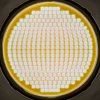JorgeGonzales
Well-Known Member
Or on the flip side the highly efficient cobs let you compensate for the lower electrical efficiency monos that in turn help the PLANTS MORE EFFICIENTLY (remember they're the ones doing all the work!) produce essential oils/thc, terps, carotenoids/pigment, etc they may not have fully pronounced under standard whites.
Quick googling on the go:
"PAR as described above does not distinguish between different wavelengths between 400 and 700 nm, and assumes that wavelengths outside this range have zero photosynthetic action. If the exact spectrum of the light is known, the photosynthetic photon flux density (PPFD) values in μmol/s can be modified by applying different weighting factor to different wavelengths. This results in a quantity called the yield photon flux (YPF).[3] The red curve in the graph shows that photons around 610 nm (orange-red) have the highest amount of photosynthesis per photon. However, because short-wavelength photons carry more energy per photon, the maximum amount of photosynthesis per incident unit of energy is at a longer wavelength, around 650 nm (deep red)."
I hesitate to say YPF is controversial, but Bugbee and friends have some interesting things to say:
"Surprisingly, we found that photosynthetic efficiency slightly decreased as YPF increased, especially in high light (Fig.
I mean that's out of context, not a cannabis study, and they used 200 and 500 PPF, so lower than we are used to, but it helps me sleep better at night not worrying about YPF. What's cool is that it was a study using white leds, and shows how different plants sometimes behave very differently to changing spectrum, and how hard it is to really tease out solid conclusions, even for professionals.
http://cpl.usu.edu/files/publications/publication/pub__4124704.pdf
Also, another gem:
"The YPF curve, however, was developed from short-term measurements made on single leaves in low light. Over the past 30 years, numerous longer-term studies with whole plants in higher light indicate that light quality has a much smaller effect on plant growth rate than light quantity."
http://journals.plos.org/plosone/article?id=10.1371/journal.pone.0099010
Bugbee stirring the pot as usual!
Last edited:


